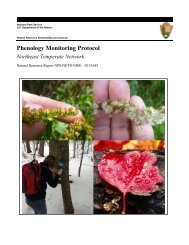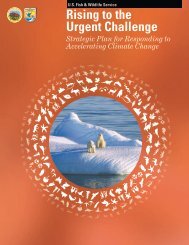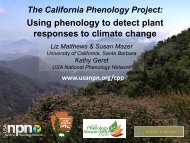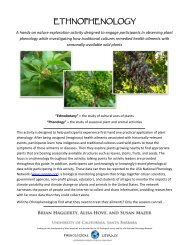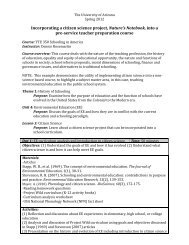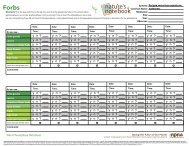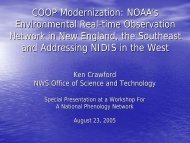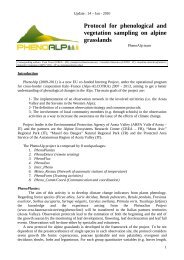The Phenology Handbook - USA National Phenology Network
The Phenology Handbook - USA National Phenology Network
The Phenology Handbook - USA National Phenology Network
You also want an ePaper? Increase the reach of your titles
YUMPU automatically turns print PDFs into web optimized ePapers that Google loves.
onstrate that spring in North America is arriving earlier than in the past, and Schwartz has estimated that the<br />
onset of spring is advancing by 1.2 days per decade across the Northern Hemisphere. <strong>The</strong>re is even preliminary<br />
evidence that phenological schedules are, in some regions in the western U.S., strongly correlated with the size<br />
and frequency of wildfires during the subsequent “fire season.”<br />
Schwartz and others have recently leveraged this phenological legacy in the U.S. to rally scientific and<br />
public interest around a national-level phenology network. <strong>The</strong> <strong>USA</strong> <strong>National</strong> <strong>Phenology</strong> <strong>Network</strong><br />
(<strong>USA</strong>-NPN: http://www.usanpn.org) is currently being designed and organized to engage federal agencies, environmental<br />
networks and field stations, educational institutions, and mass participation by citizen scientists. It<br />
is a nationwide collaboration among professional and citizen scientists designed to track the progression of the<br />
seasons, and to relate the timing and duration of phenological events to climate change, the onset and intensity<br />
of allergies, the appearance of agricultural and residential pests, the availability of natural resources such as pollinators<br />
and seed-dispersing animals, and the spread of vector-borne diseases.<br />
Many cultures throughout history have used flowering times as cues for hunting and cultural activities. In<br />
the Pacific Northwest, the many nations comprising the Nuu-Chah-Nulth of western Vancouver Island have<br />
looked to the ripening of salmonberries (Rubus spectabilis) to alert them that anadromous sockeye salmon<br />
(those that migrate from saltwater to freshwater) are abundant in nearby streams. <strong>The</strong> Blackfoot of Alberta<br />
would time their annual mid-summer tribal ceremony to the ripening of Saskatoon berries (Amelanchier<br />
alnifolia), and reportedly would time their spring hunt for bison bulls to the flowering time of the Buffalo<br />
Bean plant (<strong>The</strong>rmopsis rhombifolia).<br />
THE <strong>USA</strong> NATIONAL PHENOLOGY NETWORK (NPN)<br />
<strong>The</strong> vision of the <strong>USA</strong> NPN is to integrate available data from existing infrastructures (e.g., NASA’s satellite imagery,<br />
<strong>National</strong> Weather Service Co-Op stations, <strong>National</strong> Park Service’s annual inventories, and AmeriFlux’s<br />
biogeochemical monitoring stations), while engaging citizen scientists across the country to monitor local organisms.<br />
<strong>The</strong> component of the NPN that is actively working to inform the American public and solicit their help is<br />
the Education, Citizen Science, & Outreach working group (ECSO).<br />
<strong>The</strong> Education, Citizen Science & Outreach (ECSO) working group of the NPN<br />
In the global campaign to reduce the factors that promote global warming, there are many organizations that<br />
provide citizens with opportunities to donate money or time with the goal of reducing energy use and greenhouse<br />
gas emissions through education and outreach. <strong>The</strong>re are only a few organizations, however, that invite<br />
citizens to contribute their time and energy toward scientific monitoring and the detection of local climaterelated<br />
patterns. <strong>The</strong> ECSO working group of the NPN operates with the understanding that phenology, and the<br />
ability to measure and to record its progress over the seasons, is accessible to everyone in the country. <strong>The</strong> primary<br />
goal of ECSO programs is to bring together professional and citizen scientists, students, stewards of public<br />
and private lands, and outdoor enthusiasts to compile basic information on phenological responses to climate<br />
change; to study its nature, pace and its effects on ecosystem function; and to understand synchrony and ecological<br />
interactions among species.<br />
24



